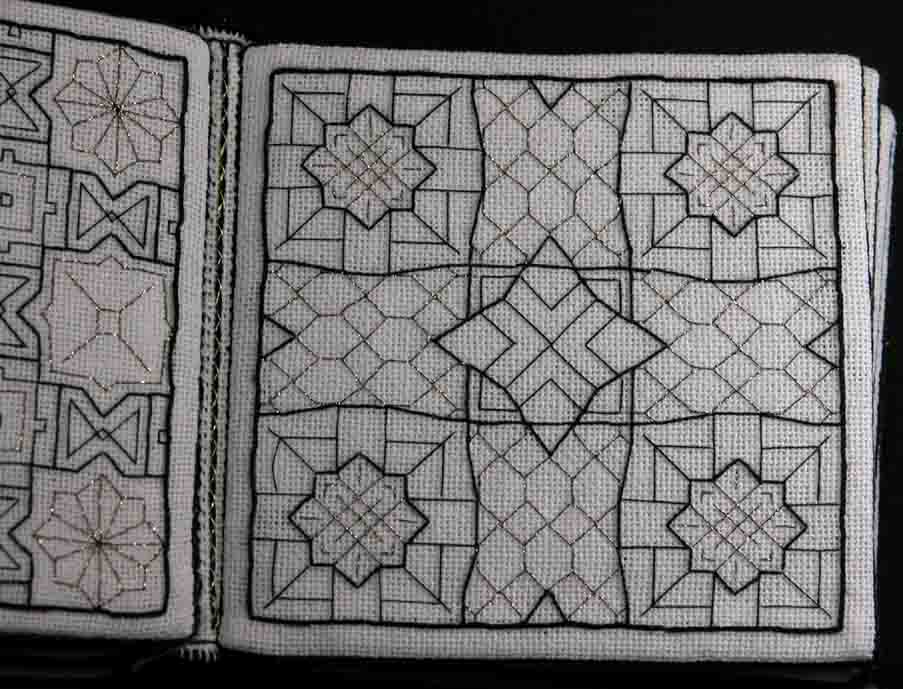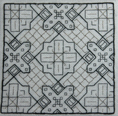Cette création de Yvette Stanton se fait remarquer par son raffinement et ne correspond plus à l'image traditionnelle du hardanger. En effet, depuis la fin des années 90 cette technique de broderie est sujette à une profonde modernisation. Les créateurs contemporains ont tendance à sortir des sentiers battus du hardanger traditionnel, donnant libre cours à leur fantaisie. Le résultat est un hardanger léger, ludique, surprenant et sophistiqué.
Le modèle de Yvette Stanton révèle clairement cette évolution. Certes, le bord anguleux au point de feston et les autres points caractéristiques du hardanger sont maintenus. Le passé plat, le point d'esprit, le point d'oeillet, le point feston, la croix de Malte, ils sont tous là. Mais leur disposition et l'enrichissement sont tels que l'ouvrage obtient un aspect plus ajouré, léger, raffiné et plus baroque que le hardanger classique. Regardez les remplissages dans ce modèle : on dirait des petites fleurs, non ?
Qui plus est, de la toile elle-même, il n'en reste plus guère. Elle est entièrement brodée ou ajourée, ce qui donne à l'ouvrage l'apparence d'une dentelle. Voilà pour quoi j'ai craqué : le hardanger moderne !
J'ai brodé ce napperon sur de la toile Lugana blanche avec DMC perlé 8 et 12, n° 712 et blanc. L'ouvrage mesure 55 cm sur 30 cm.
Het hardangerborduurwerk dat ik u in dit artikel wens voor te stellen werd ontworpen door Yvette Stanton. Het patroon heb ik aangetroffen in AWARD-WINNING DESIGNS HARDANGER 2000, een uitgave van Nordic Needle.
Het was liefde op het eerste gezicht : zodra ik de foto onder ogen kreeg heb ik het meteen gekocht, in de zekerheid dat ik het ooit wel eens zou borduren. Na jarenlang op de wachtlijst te hebben doorgebracht is het dan toch uitgevoerd geraakt. Borduursters hebben meer projecten dan tijd, nietwaar ?
Deze creatie van Yvette Stanton is opvallend door zijn verfijning en beantwoordt niet meer aan het traditionele beeld van hardanger. Sinds het einde van de jaren 90 is deze borduurtechniek inderdaad aan grondige vernieuwing onderhevig. De hedendaagse designers vertonen de tendens om de strakke en strenge hardangerregels te verlaten en hun fantasie de vrije loop te laten. Het resultaat is speelser en verfijnder dan de traditionele hardanger.
Het model van Yvette Stanton geeft duidelijk deze evolutie aan. Toegegeven, de klassieke hoekige festonboord en de gebruikelijke hardangersteken blijven gehandhaafd. De platsteek, de lussenspin, de madeiraster, de festonsteek, het maltezerkruis, ze zijn er allemaal. Maar ze zijn zodanig bewerkt en geplaatst dat het borduurwerk een veel opener, lichter, geraffineerder en barokker aspect vertoont dan de klassieke hardanger. Kijk maar eens naar de vullingen in dit patroon : het lijken wel bloempjes.
Van de stof zelf is bovendien niets meer te zien : ze is helemaal geborduurd of opengewerkt, waardoor het geheel op kantwerk gaat lijken. En dat is nu net waarvoor ik ben gevallen : de moderne hardanger !
Ik heb dit sierkleedje geborduurd op Lugana wit met DMC perlé 8 en 12, kleuren 712 en wit. Het meet 55 cm op 30 cm.
The hardanger embroidery I'd like to present you in this post has been designed by Yvette Stanton. I discovered the pattern in the Nordic Needle publication AWARD-WINNING DESIGNS HARDANGER 2000.
It was love at first sight. Its very picture made me buy it on the spot, in the conviction that I would embroider it most certainly, no doubt about it, ...once. After having spent several years on the waiting list it is there at last. Embroiderers tend to have much more projects than they have time, don't they ?
This creation of Yvette Stanton attracts attention because of its refinement and doesn't answer to the traditional image of hardanger anymore. Since the end of the 90's this embroidery technique is liable to thorough modernization. Today's designers have tendency to leave the strict rules of traditional hardanger, giving their imagination free rein. The result is a fanciful and elegant embroidery.
Yvette Stanton's pattern clearly demonstrates this evolution. Admittedly, the classical angular border in buttonhole stitch and the usual hardanger stitches are maintained. The satin stitch, the dove's eye, the eyelet, the buttonhole stitch, the Maltese cross, they are all there. But by their arrangement and enrichment they give the embroidery a much more open, lighter, refined and baroque aspect than the classical hardanger does. Take a look for example at the fillings in this model : don't they just look like little flowers ?
Moreover, the fabric itself is still only barely visible. It is completely embroidered or open worked, creating a lacy look. This is precisely what I fancied : the modern hardanger !
I embroidered this doily on Lugana white with DMC perlé 8 and 12, colours 712 and white. It measures 55 cm by 30 cm.
 Yvette Stanton est Australienne et créatrice de patrons de broderie.
Yvette Stanton est Australienne et créatrice de patrons de broderie.C'est avec ce modèle de napperon qu'elle emporta, en 2000, le premier prix au concours annuel organisé par Nordic Needle.
Depuis lors, elle a publié plusieurs livres contenant de superbes patrons de toutes les techniques de broderie dans lesquelles elle s'est spécialisée : Hardanger, Broderie Blanche, Mountmellick.
L'une de ses publications les plus remarquables s'appelle The Left-Handed Embroiderer's Companion (Manuel à l'usage de la Brodeuse Gauchère), un dictionnaire qui expose, étape par étape, comment effectuer chaque point de broderie... étant gauchère.
Yvette Stanton organise des ateliers à travers toute l'Australie et contribue à de nombreux magazines de broderie.
Voici son site sur le web : http://www.vettycreations.com.au/
Yvette Stanton is een Australische ontwerpster van borduurpatronen.
Met dit sierkleedje sleepte ze de eerst prijs in de wacht in het Nordic Needle-concours van 2000.
Sindsdien publiceerde ze verschillende boeken die prachtige patronen bevatten van de borduurtechnieken waarin ze is gespecialiseerd : Hardanger, Wit Borduurwerk, Mountmellick.
Een van haar merkwaardigste publicaties is The Left-Handed Embroiderer's Companion (Borduurhandboek voor Linkshandigen), een lexicon waarin stap voor stap de uitvoering van alle borduursteken wordt aangetoond, maar dan voor linkshandigen.
Haar website : http://www.vettycreations.com.au/
Yvette Stanton is an Australian embroidery pattern designer.
She deservedly won a first prize with this doily at the Nordic Needle's contest of 2000.
Since then, she published several books containing beautiful patterns of all embroidery techniques in which she specializes : Hardanger, White Embroidery, Mountmellick.
One of her most remarkable publications is The Left-Handed Embroiderer's Companion, a dictionary in which she demonstrates step by step how to execute each embroidery stitch... being left-handed.
Yvette Stanton organizes workshops throughout Australia and renders assistance to several embroidery magazines.
Her website : http://www.vettycreations.com.au/














































